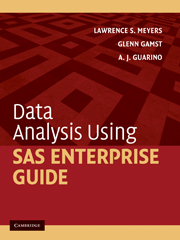Book contents
- Frontmatter
- Contents
- Preface
- Acknowledgments
- I Introducing SAS Enterprise Guide
- II Performing Analyses and Viewing Output
- III Manipulating Data
- IV Describing Data
- 8 Descriptive Statistics
- 9 Graphing Data
- 10 Standardizing Variables Based on the Sample Data
- 11 Standardizing Variables Based on Existing Norms
- V Score Distribution Assumptions
- VI Correlation and Prediction
- VII Comparing Means: The t Test
- VIII Comparing Means: ANOVA
- IX Nonparametric Procedures
- X Advanced ANOVA Techniques
- XI Analysis of Structure
- References
- Author Index
- Subject Index
11 - Standardizing Variables Based on Existing Norms
Published online by Cambridge University Press: 05 June 2012
- Frontmatter
- Contents
- Preface
- Acknowledgments
- I Introducing SAS Enterprise Guide
- II Performing Analyses and Viewing Output
- III Manipulating Data
- IV Describing Data
- 8 Descriptive Statistics
- 9 Graphing Data
- 10 Standardizing Variables Based on the Sample Data
- 11 Standardizing Variables Based on Existing Norms
- V Score Distribution Assumptions
- VI Correlation and Prediction
- VII Comparing Means: The t Test
- VIII Comparing Means: ANOVA
- IX Nonparametric Procedures
- X Advanced ANOVA Techniques
- XI Analysis of Structure
- References
- Author Index
- Subject Index
Summary
Overview
Many measures developed by social and behavioral researchers, such as those of achievement, cognitive abilities, and personality, are published with a set of existing norms. Such norms are usually based on large and diverse nationally drawn samples. For our purposes, two statistical characteristics of such a normative sample are of interest to us: the mean and the standard deviation. In Chapter 10, we used the mean and standard deviation of the research sample as our base to compute the standard score; here, we discuss the procedure of computing standard scores based on the mean and standard deviation of the normative sample. This process is very similar to what was described in Chapter 7 when we computed a new variable, and so we will more quickly outline the steps that are needed; readers are referred to Section 7.3 for a more complete explanation of these steps.
Numerical example
We will use the same data set that we used in Chapter 10. The instrument used to measure the personality dimensions was the NEO Five-Factor Inventory (which measures five personality factors, namely neuroticism, extraversion, openness, agreeableness, and conscientiousness; see Costa & McCrae, 1991). We work with the personality factor of conscientiousness for this example. The combined male–female mean and standard deviation of the normative sample reported in the test manual (Costa & McCrae, 1992) is 34.57 and 5.88, respectively. NEO scores are ordinarily reported as linear T scores, and so we will compute these.
- Type
- Chapter
- Information
- Data Analysis Using SAS Enterprise Guide , pp. 111 - 116Publisher: Cambridge University PressPrint publication year: 2009



